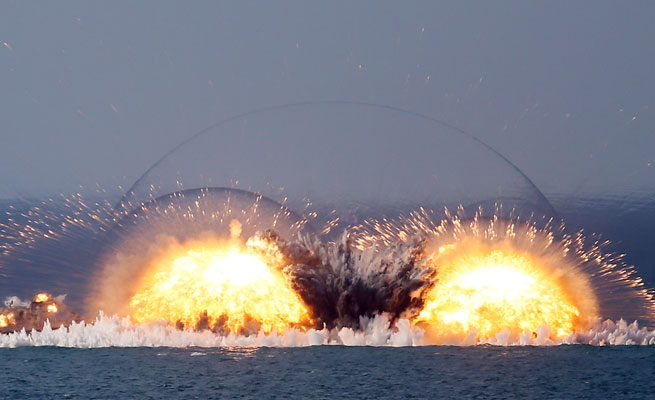Thermobaric weapon

Vacuum bombs, or thermobaric weapon, work in two stages. Stage one releases a large cloud of combustible material, usually fuel or small metal particles such as aluminium. Stage two triggers an explosion that ignites this material to create a massive fireball and a shock wave.
Thermobaric weapons are also called vacuum bombs because the explosion sucks up all the oxygen around the device. This process leaves victims close to the explosion unable to breathe, killing them by asphyxiation.
The missiles are filled with a highly explosive fuel and chemical mix, which on exploding can cause supersonic blast waves that can obliterate everything in their path, including buildings and humans.
The first-stage charge distributes an aerosol made up of very fine material – from a carbon-based fuel to tiny metal particles. A second charge ignites that cloud, creating a fireball, a huge shock wave, and a vacuum as it sucks up all surrounding oxygen.
The blast wave can last for significantly longer than a conventional explosive and is capable of vaporising human bodies.
The bombs have been used by Russian and western forces since the 1960s. The US relied on them in its attempts to eliminate al-Qaida in the mountains in Afghanistan. Hellyer said Russia had a longer track record with them than the west. “Russia has systems right across the spectrum … from quite small tactical weapons, to huge, air-launched bombs.
The effects of thermobaric weapons are much more intense and destructive than a more conventional bomb. The explosion lasts longer and happens at a much higher temperature. As a result, these weapons can devastate vast areas of land, destroy buildings, and can even vaporise a human body from the extreme heat. The materials used are also often highly toxic and can be as dangerous as chemical weapons.
Thermobaric arms come in various sizes. They are not seen as very effective against heavily armoured targets, so we wouldn’t expect them to be used on targets such as tanks. They are suited to taking out infrastructure, troops and civilians.
Development
The RPO-A and upgraded RPO-M are infantry-portable RPGs, designed to fire thermobaric rockets. The RPO-M, for instance, has a thermobaric warhead with a TNT equivalence of 5.5 kg (12 lb) and destructive capabilities similar to a 152 mm (6 in) high-explosive fragmentation artillery shell.
The RMG is a further derivative of the RPG-26 that uses a tandem-charge warhead, with the precursor HEAT warhead blasting an opening for the main thermobaric charge to enter and detonate inside. The RMG’s precursor HEAT warhead can penetrate 300 mm of reinforced concrete or over 100 mm of rolled homogeneous armour, thus allowing the 105 mm (4.1 in)-diameter thermobaric warhead to detonate inside.
Many Russian Air Force munitions also have thermobaric variants. The 80 mm (3.1 in) S-8 rocket has the S-8DM and S-8DF thermobaric variants. The S-8’s 122 mm (4.8 in) brother, the S-13, has the S-13D and S-13DF thermobaric variants. The S-13DF’s warhead weighs only 32 kg (71 lb), but its power is equivalent to 40 kg (88 lb) of TNT. The KAB-500-OD variant of the KAB-500KR has a 250 kg (550 lb) thermobaric warhead. The ODAB-500PM and ODAB-500PMV unguided bombs carry a 190 kg (420 lb) fuel–air explosive each.
Father of all bombs
The bomb is reportedly similar to the US military’s GBU-43/B Massive Ordnance Air Blast which is often unofficially called “Mother of All Bombs” derived from its official military acronym “MOAB”. This weapon would therefore be the most powerful conventional (non-nuclear) weapon in the world.
“FOAB” was successfully field-tested in the late evening of 11 September 2007. The new weapon is to replace several smaller types of nuclear bombs in the Russian arsenal.
According to General Aleksandr Rukshin, the Russian Deputy Chief of Staff, the new bomb was smaller than the MOAB but much deadlier because the temperature at the centre of the blast is twice as high. He claimed the bomb’s capabilities are comparable to nuclear weapons, but unlike nuclear weaponry known for its radioactive fallout, use of the weapon does not damage or pollute the environment beyond the blast radius.
In comparison, the MOAB produces the equivalent of 11 tons of TNT from 8 tons of high explosive. The blast radius of the FOAB is 300 meters, almost double that of the MOAB, and the temperature produced is twice as high.
Cluster bombs
Cluster bombs are a weapon “on the border between conventional bombs and landmines”, Professor Clarke explains.
Delivered by planes, artillery or missiles, they open into the air and release up to 100 submunitions or ‘bomblets’ over a large area.
The use of cluster bombs in conflict is legal under international law – but only on military targets.




